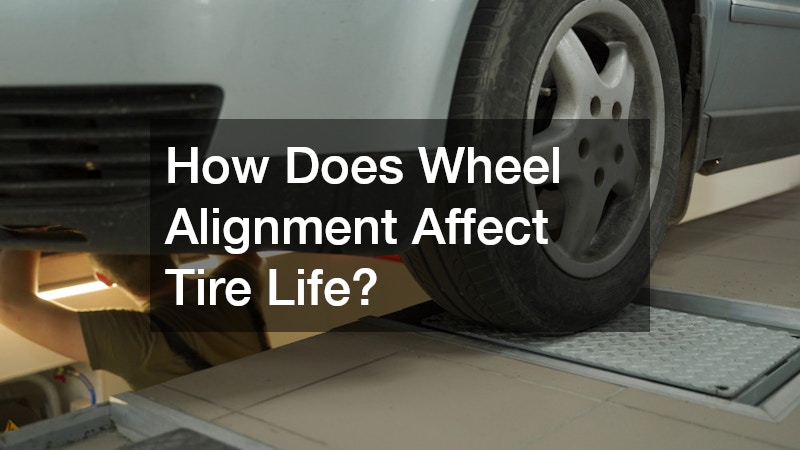Maintaining your vehicle involves more than just regular servicing and oil changes. One often overlooked but essential aspect of vehicle care is wheel alignment. Proper alignment not only ensures a smoother and safer driving experience but also has a direct impact on how long your tyres last.
In this article, we’ll explore how wheel alignment affects tyre life, the signs of misalignment and why it pays to stay on top of this often-neglected service.
What Is Wheel Alignment?
Wheel alignment refers to adjusting the angles of your vehicle’s wheels so they’re set to the car manufacturer’s specifications. These adjustments involve three key angles: camber, toe and caster.
Camber refers to the inward or outward tilt of the tyre when viewed from the front of the vehicle. If the top of the tyre tilts inwards or outwards too much, it can result in uneven wear. Toe describes the direction the tyres point relative to the centre of the vehicle when viewed from above. Wheels that point too far inward or outward cause the tyres to scrub against the road surface. Caster refers to the angle of the steering axis when viewed from the side and influences the vehicle’s stability and steering response. Driving over potholes, kerbs or uneven terrain can gradually shift these angles out of alignment, causing long-term wear issues.
The Link Between Alignment & Tyre Longevity
When your wheels are not aligned properly, your tyres do not make optimal contact with the road surface. This leads to uneven wear patterns. For instance, incorrect camber can cause the inner or outer edge of the tyre to wear down faster than the rest of the tread. Misaligned toe angles can result in tyres that appear feathered or scalloped along the edges due to continuous sideways scrubbing against the road. When tyres are forced to roll against resistance or at improper angles, they deteriorate more quickly and unevenly.
Proper wheel alignment ensures that all four tyres wear evenly, maintaining maximum tread life and improving performance. It helps tyres last longer, deliver better traction and provide a smoother ride. Neglecting alignment accelerates wear, making it necessary to replace tyres more frequently—often well before their intended lifespan.
Financial Implications of Poor Alignment
Tyres are a major investment, especially if your vehicle requires premium or specialised options. Replacing tyres earlier than necessary due to misalignment can be a significant financial burden. What’s more, misaligned wheels reduce fuel efficiency. When alignment is off, the increased rolling resistance forces the engine to work harder, leading to higher fuel consumption.
These added costs accumulate quickly. Regular alignment checks cost a fraction of what you’d spend on premature tyre replacements or additional fuel. Keeping your wheels properly aligned is a simple way to protect your investment and reduce your vehicle’s long-term operating costs.
Safety Considerations
While tyre life is a major concern, safety is even more critical. Misaligned wheels compromise your vehicle’s handling, particularly at higher speeds or during emergency situations. You may notice the car pulling to one side even when the steering wheel is straight. The steering wheel itself might appear off-centre or feel loose and unresponsive. In some cases, you may experience vibrations through the wheel while driving, particularly at higher speeds.
These handling issues reduce your ability to control the vehicle precisely, increasing the risk of accidents. Uneven tyre wear also affects braking performance. In wet or slippery conditions, tyres with uneven tread may struggle to maintain grip, leading to longer stopping distances and a higher likelihood of skidding.
How Often Should You Check Your Alignment?
Most vehicle manufacturers recommend checking wheel alignment at least once a year. However, you should have it inspected more frequently if you regularly drive on rough terrain, hit a pothole or kerb with significant force or notice signs such as uneven tyre wear or your car pulling to one side. It’s also a good idea to include an alignment check when installing new tyres, ensuring they wear evenly from the start.
Being proactive about alignment can prevent further damage and improve the overall lifespan of your tyres. Timely intervention can save you from more costly repairs down the road.
The Role of Regular Maintenance
Wheel alignment is just one part of a broader routine that keeps your vehicle running efficiently. Tyre rotations should be performed regularly to ensure even wear across all four tyres. Maintaining the correct tyre pressure is equally important, as both under-inflated and over-inflated tyres can cause uneven wear and affect your vehicle’s handling. Worn suspension components such as shocks, struts and control arms can gradually alter your vehicle’s alignment and should be inspected during routine servicing. Promptly addressing mechanical issues can prevent misalignment and protect your tyres from unnecessary wear.
Including alignment checks as part of your regular vehicle maintenance not only helps maximise tyre life but also enhances safety, performance and cost-efficiency.
Why Wheel Alignment Is Key to Tyre Longevity and Safety
Understanding how wheel alignment affects tyre life highlights the importance of routine vehicle care. Misaligned wheels may seem like a minor issue, but over time they lead to uneven wear, reduced fuel economy, compromised handling and premature tyre replacement.
Whether you’re commuting in the city or heading out on an interstate road trip, maintaining correct wheel alignment helps you get the most out of your tyres, saving money and improving safety. Make it part of your standard vehicle maintenance plan and you’ll benefit from better performance and longer-lasting tyres.
.

